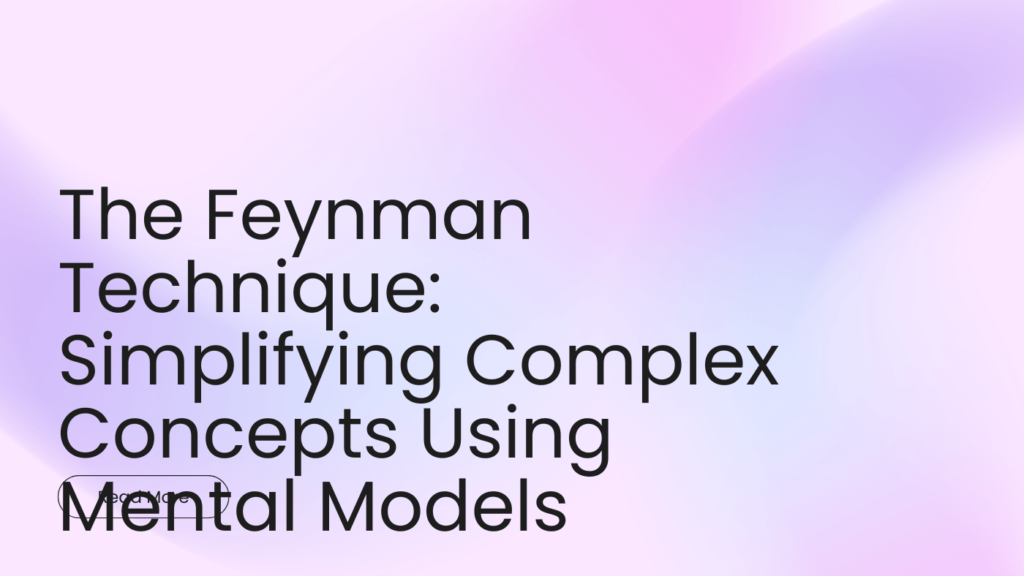Mastering Complexity: The Feynman Technique and Mental Models
Ever felt overwhelmed by a complex topic? You’re not alone. We all struggle to truly understand and retain information, especially when dealing with intricate concepts. But what if there was a simple, powerful technique to not only grasp these ideas but also solidify your understanding? Enter the Feynman Technique, a learning method championed by the brilliant physicist Richard Feynman. Combined with the strategic use of mental models, it offers a potent approach to simplifying complex ideas and fostering deep learning.
Understanding the Feynman Technique: Teaching to Learn
The Feynman Technique is more than just memorization; it’s about genuine understanding. It’s built on the principle that the best way to learn something is to teach it. Feynman believed that if you can’t explain something simply, you don’t understand it well enough. The technique involves four key steps:
- Choose a Concept: Identify the specific topic you want to understand. Be precise. For example, instead of “Quantum Physics,” choose “Quantum Entanglement.”
- Teach It: Explain the concept as if you were teaching it to someone who knows nothing about it. Use simple language, avoid jargon, and focus on the core ideas. Pretend you’re explaining it to a 12-year-old.
- Identify Gaps: As you teach, you’ll inevitably encounter areas where your understanding is weak. These are gaps in your knowledge. Note them down. This is where the real learning begins!
- Review and Simplify: Go back to your source material (textbooks, articles, lectures) and fill in the gaps in your understanding. Then, simplify your explanation even further. Continue this process until you can explain the concept clearly and concisely, without resorting to jargon.
By forcing yourself to explain something in simple terms, you’re actively engaging with the material and identifying weaknesses in your understanding. This active recall process is far more effective than passive reading or memorization. Research in cognitive psychology supports the benefits of active recall and elaboration for learning. (See Karpicke, J. D., & Blunt, J. R. (2011). Retrieval practice produces more learning than elaborative studying with concept mapping. *Science*, *333*(6043), 772-775.)
The Power of Mental Models: Frameworks for Thinking
While the Feynman Technique is excellent for drilling down into a specific concept, learning with mental models provides a broader framework for understanding the world. Mental models are simplified representations of how things work. They are cognitive tools that help us make sense of complex situations, make better decisions, and learn more effectively.
Think of mental models as shortcuts in your brain. They allow you to quickly process information and predict outcomes based on past experiences and established principles. Some useful mental models include:
- First Principles Thinking: Breaking down a problem into its fundamental truths and reasoning up from there. (Elon Musk is a famous proponent)
- Inversion: Thinking about a problem backward to identify potential pitfalls and solutions.
- Occam’s Razor: The simplest explanation is usually the best.
- The Pareto Principle (80/20 Rule): 80% of the effects come from 20% of the causes.
- Feedback Loops: Understanding how actions create reactions that influence future actions.
Charlie Munger, Warren Buffett’s longtime business partner, is a strong advocate for using a “latticework of mental models.” He argues that having a diverse collection of mental models allows you to approach problems from multiple angles and make more informed decisions. He details this extensively in “Poor Charlie’s Almanack” (Munger, C. T. (2006). *Poor Charlie’s Almanack: The Wit and Wisdom of Charles T. Munger*. Third Edition. PCA Publications.)
Combining the Feynman Technique and Mental Models for Ultimate Learning
The true power comes when you combine the Feynman Technique with the use of relevant mental models. Here’s how:
- Identify the Concept and Relevant Mental Models: Before diving into the Feynman Technique, identify which mental models might be applicable. For example, when learning about supply and demand in economics, the “feedback loops” and “Pareto Principle” mental models could be helpful.
- Teach Using Mental Models as a Framework: As you explain the concept, actively try to incorporate the relevant mental models. How does the concept relate to these mental models? Do they provide a useful perspective?
- Identify Gaps and Refine Understanding: As you explain and use the mental models, you’ll uncover gaps in your knowledge. Fill these gaps using reliable resources.
- Simplify and Iterate: Continue simplifying your explanation and integrating the mental models until you have a clear and concise understanding of the concept.
For example, when simplifying complex ideas in software engineering, consider using the “Abstraction” mental model. When explaining object-oriented programming, use the abstraction model to explain how complex systems are built from simpler, reusable components.
Real-World Examples
- Learning Physics: Use the Feynman Technique to explain concepts like “Newton’s Laws of Motion” to a beginner. Simultaneously, apply the “First Principles Thinking” mental model to understand the underlying assumptions and limitations of these laws.
- Understanding Finance: Apply the Feynman Technique to explain “Compound Interest.” Use the “Exponential Growth” mental model to visualize the power of compounding over time.
- Mastering Marketing: Explain “Customer Lifetime Value (CLTV)” using the Feynman Technique. Incorporate the “Pareto Principle” to understand that a small percentage of customers often contribute the majority of revenue.
Practical Tips for Using the Feynman Technique and Mental Models
- Write it Down: Physically writing out your explanation helps solidify your understanding.
- Use Visual Aids: Diagrams, flowcharts, and mind maps can be powerful tools for simplifying complex concepts.
- Don’t Be Afraid to Admit You Don’t Know: The Feynman Technique is about identifying gaps in your knowledge, not pretending to know everything.
- Practice Regularly: The more you practice, the better you’ll become at simplifying complex ideas and applying mental models.
- Seek Feedback: Ask someone to listen to your explanation and provide feedback on its clarity and accuracy.
Conclusion
The Feynman Technique, combined with the strategic application of mental models, offers a powerful approach to learning and understanding complex topics. By actively engaging with the material, identifying gaps in your knowledge, and leveraging the power of mental models, you can transform yourself from a passive learner into an active and effective master of information. Start applying these techniques today and unlock your full learning potential!
This journey of learning with mental models and utilizing the Feynman Technique will allow you to conquer complexity and build a robust foundation of knowledge.


